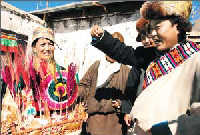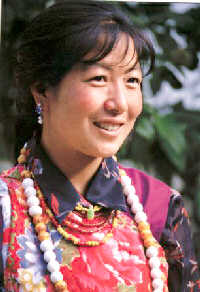|
Aboriginals in Tibet
( 2005-10-27 )
Of the many ethnic groups living in Tibet, the Tibetan, Naxi, Nu, Hui, Moinba, and Lhoba together with Deng and Sherpa groups have been inhabitants of Southwest China's Tibet Autonomous Region since ancient times. Among them, Tibetans are the dominant inhabitants, accounting for 92.2 percent of the whole regional population, and the last four groups (Moinba, Lhoba, Deng, and Sherpa) are the natives distributed only in Tibet -- no other places in China contain them.
Tibetans
 Tibetans are the principal inhabitants of Tibet. Their language belongs to the Tibetan sub-group of the Tibetan-Burmese group of the Sino-Tibetan language family. There are three main dialects: U-Tsang, Kham, and Amdo. Most Tibetans work in agriculture and animal husbandry, while urban residents for the most part work in handicrafts, industry, and commerce. Ethnic Tibetans follow Tibetan Buddhism. They are enthusiastic and open-minded and good at singing and dancing. The Tibetan songs are pleasant to the ears and are often accompanied by dance. Tibetans are the principal inhabitants of Tibet. Their language belongs to the Tibetan sub-group of the Tibetan-Burmese group of the Sino-Tibetan language family. There are three main dialects: U-Tsang, Kham, and Amdo. Most Tibetans work in agriculture and animal husbandry, while urban residents for the most part work in handicrafts, industry, and commerce. Ethnic Tibetans follow Tibetan Buddhism. They are enthusiastic and open-minded and good at singing and dancing. The Tibetan songs are pleasant to the ears and are often accompanied by dance.
Although different areas have different clothing, Tibetans traditionally wear long-sleeved silk or cloth jackets which men top with loose robes and women with long sleeveless gowns that are tied at the waist with a sash. Married women frequently wear an apron with a multicolor design. Both women and men braid their hair and love wearing ornaments.
The staple food is zanba (roasted qingke barley flour or pea meal), while tea with butter or milk is the favorite of all Tibetans. They have a liking for qingke barley wine, beef, and mutton, but do not eat horses.
In ancient times Tibetans buried their dead in the ground but in modern times Tibetans practice sky burial (in which the corpse is chopped to bits and exposed on a mountain face to be eaten by vultures and other birds of prey), cremation, and water burial.
Moinba
 The Moinba people have lived on the Tibet Plateau since ancient times. For the most part they are distributed in the Moinyu region in the south, with some scattered in Medog, Nyingchi, and Cona counties. Linguistically, the Moinba belong to the Moinba sub-group of the Tibetan-Myanmar group of the Sino-Tibetan language family. In terms of dialects, the language is complex. While there is no written language, most Moinba people can speak and write Tibetan. The Moinba people have lived on the Tibet Plateau since ancient times. For the most part they are distributed in the Moinyu region in the south, with some scattered in Medog, Nyingchi, and Cona counties. Linguistically, the Moinba belong to the Moinba sub-group of the Tibetan-Myanmar group of the Sino-Tibetan language family. In terms of dialects, the language is complex. While there is no written language, most Moinba people can speak and write Tibetan.
Their livelihood is based on agriculture, supplemented by animal husbandry, forestry, hunting, and handicrafts.
Both women and men dress in robes made of pulu (a woolen fabric). They also wear a small brown-crowned, orange-rimmed hat gaped in the front, or a black felt cap. The women wear bracelets and earrings and other ornaments and men have a chopper hanging at their waists.
Men and women alike enjoy drinking wine and dipping snuff. The Moinba diet is based on rice, corn, buckwheat and jizhuagu (glutinous highland millet). Men and women alike enjoy drinking wine and dipping snuff.
Most Moinba people adhere to Tibetan Buddhism; however, in some areas some people practice traditional shamanism. The dead are generally given water burial, but earth burial, sky burial, and cremation are also practiced.
Lhoba
The Lhoba people are mainly found in the Lhoyu region of southeastern Tibet, with some scattered in Mainling, Medog, Zayu, Lhunze, and Nang counties. Their language also belongs to the Tibet-Burmese group of the Sino-Tibetan language family. Having no written language of their own, they normally use Tibetan for written communications.
The Lhoba are an essentially agricultural people. Corn and jizhuagu, supplemented by rice and buckwheat, are staple foods.
At the same time, they value the goods they weave from bamboo. Men favor a wool woven sleeveless jacket that extends to the waist and round, helmet-like hat trimmed with bear fur or rattan (a kind of straw). Women wear a short, round-collared, narrow-sleeved jacket and a tight tubular skirt that extends a little below the knee. From knee to ankle, the leg is wrapped in cloth puttee.
Deng
The Deng people for the most part live in Zayu County of Nyingchi Prefecture. Linguistically, they also belong to the Tibetan-Myanmar group of the Sino-Tibetan language family. They have no written language, but keep records by notching wood, tying knots, or arranging sticks or branches. Deng people believe in ghosts. They live in two-story structures, themselves living above, while housing cattle and poultry below.
The women commonly wear long, drum-like silver earrings, a headdress covering the forehead, and a string of beads or silver jewelry around the neck. They wear silk skirts and go barefooted. Men wear a black cloth wound about their heads and silver earrings.
Up until the 1950s, the Deng people mostly lived deep in the mountain forests, surviving on slash-and-burn agriculture and hunting and gathering. More recently they have moved into terraced river valleys with the aid of the government.
Sherpa
The Sherpa people are concentrated in Chentang in Dinggye County as well as Zham and other areas that border Nepal. They are divided into five surnames; marriage within the same surname is taboo. They are Buddhists. Their homes are two-story wooden structures. Both men and women wear white woolen short-sleeved coats edged in black. The Sherpa people are noted for the gifted talent of high mountain climbing. They are the best guides for Mountain Everest climbing.
|

